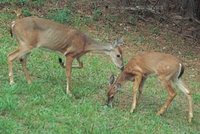Red-breasted Nuthatch
Monday, October 8th, 2007Another very warm fall day. The morning was sunny with a deep blue, cloudless sky, calm and rather quiet in the front yard, except for Chickadees and Titmice around the feeders, and Carolina Wrens and a Pine Warbler singing in the woods. A Phoebe sang in a neighbor’s yard. A Monarch butterfly sailed overhead, backlit against the blue.
Then from high in the pinetops on my right, I heard a small, sharp Ank-ank! Ank-ank! The calls of a Red-breasted Nuthatch. It was too high in the pines to see, and although it called repeatedly for three or four minutes, it gradually moved away to the east and out of hearing. Even though I didn’t see it, and it didn’t stay around long, I was ridiculously happy to hear these funny little calls that are often described as sounding like a tin horn.
Red-breasted Nuthatches live year-round in northern coniferous forests, but are well known for having “irruptive” years in which they are seen in abundance much further south during the fall and winter. Similar to our southern Brown-headed Nuthatches, they are small, stubby birds, with bluish-gray back, soft cinnamon-red breast and black head, with a vivid black streak through the eye and bright white stripe over the eye. They typically move head down on the trunks of trees, searching for insects, and they frequently come to feeders.
This year seems to be one of their irruptive years – a good year to take advantage of the chance to see them here. There have been numerous reports of sightings in Georgia, so I’ve been watching and listening for them but until today hadn’t had any luck. Now it’s good to know they’re around in our area, too – at least passing through now and then.
